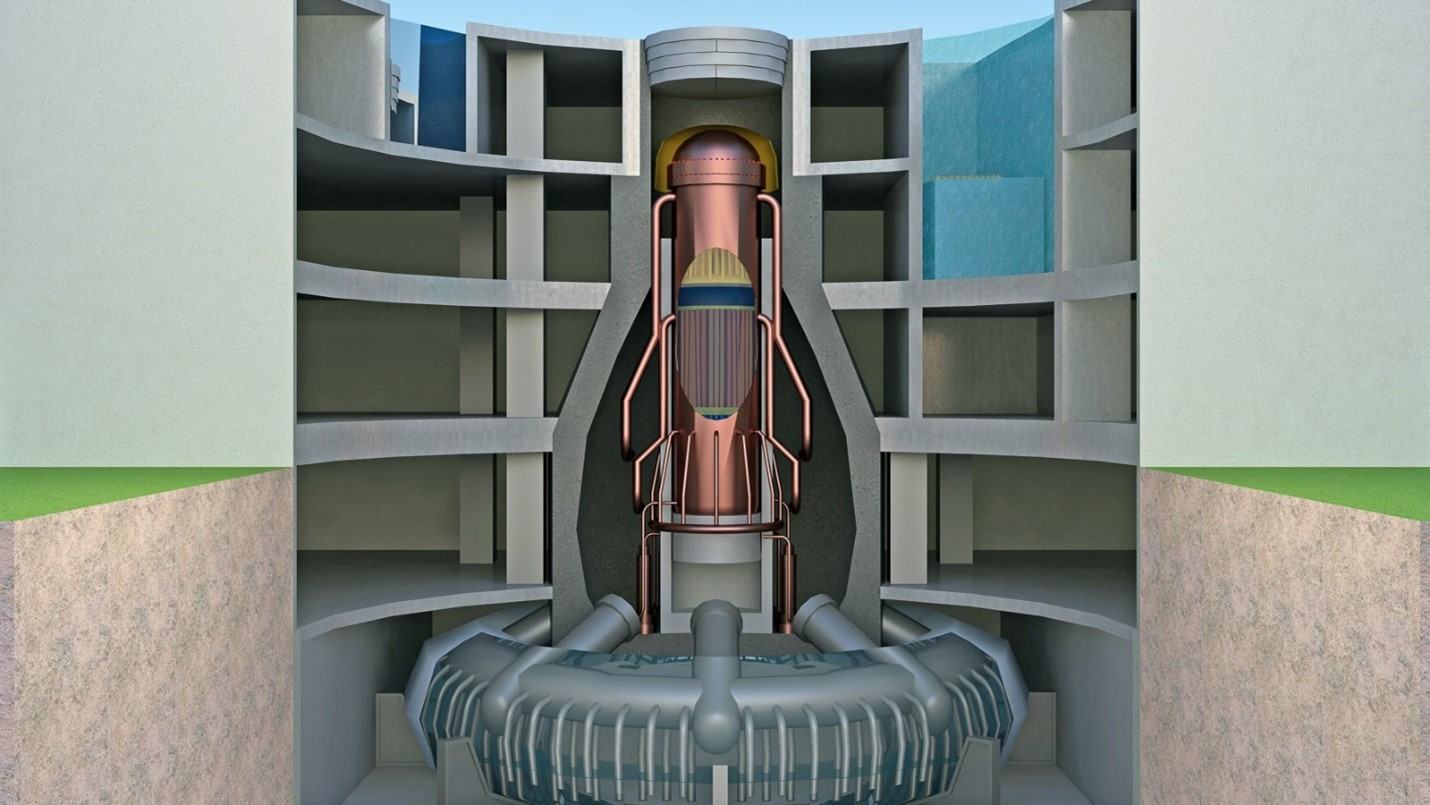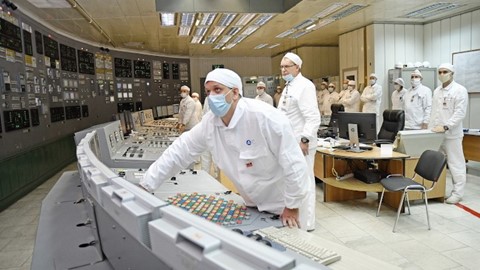Still image from the session. From left to right are Judi Greenwald, Harlan Bowers, Simon Irish, Mike Laufer, and Jake DeWitte.
The 2021 ANS Winter Meeting included an executive session on advanced reactor licensing, featuring the leaders of four of the top advanced reactor companies: Mike Laufer, chief executive officer of Kairos Power; Jake DeWitte, CEO of Oklo; Simon Irish, CEO of Terrestrial Energy; and Harlan Bowers, president of X-energy.
E.ON subsidiary Preussen Elektra’s Grohnde nuclear plant, located near the town of Hameln in Lower Saxony, on the banks of the Weser River. (Wikimedia/Heinz-Josef Lücking)
Spent fuel casks are loaded at Oyster Creek’s dry storage pad. (Photo: Holtec)
The Nuclear Regulatory Commission has proposed a $150,000 fine for apparent security-related violations at the Oyster Creek nuclear power plant in New Jersey. Oyster Creek permanently ceased operations in 2018, and ownership of the plant was transferred to Holtec Decommissioning International for decommissioning in July 2019.
October 8, 2021, 3:31PMUpdated December 31, 2021, 4:16PMNuclear NewsJoseph Campbell; Photos by Joseph Campbell and Peter Ritchie, INL The first of three phases of the Advanced Test Reactor’s sixth core overhaul culminated with the removal of the 31-ton stainless steel vessel top head on July 1, for the first time since 2004. The vessel and top head underwent extensive inspection, laser scanning, and upgrade as part of the overhaul. (Photo: JC)
As 2021 closes, Nuclear News is taking a look back at some of the feature articles published each month in the magazine. The October issue focused on plant maintenance and outage management with multiple articles looking at efficient ways to deal with plant maintenance. The article below looks at the herculean effort by INL to lead a full overhaul of the Advanced Test Reactor--a task that happens about every 10 years.
Out of the frenzy of nuclear technology and engineering development at the height of the Atomic Age, a few designs stand out above the rest—designs so innovative that they would not be surpassed for years, or even decades. An example of this unsurpassed design brilliance exists in the form of Idaho National Laboratory’s Advanced Test Reactor.
“ATR is really a beautiful machine,” said Sean O’Kelly, associate lab director for the ATR Complex. “The elegant cloverleaf core and control systems were a stroke of genius that solved just about every key problem of test reactor design. The designers’ solutions to those problems give us a testing capacity and flexibility that have yet to be matched.”
September 10, 2021, 8:22AMUpdated December 31, 2021, 7:15AMNuclear NewsThomas R. Wellock An aerial view of the Hanford reservation and Columbia River that shows the N (nearest), KE/KW (center), and B (top right) reactors. (Photo: U.S. DOE )
In March 1972, Stephen Hanauer, a technical advisor with the Atomic Energy Commission, met with Norman Rasmussen, a nuclear engineering professor at the Massachusetts Institute of Technology. The AEC had recruited Rasmussen to develop a report, The Reactor Safety Study (WASH-1400), to estimate the probabilities and consequences of a major nuclear power plant accident. With thousands of safety components in a modern reactor, the task was mind-boggling. Rasmussen proposed a novel approach based on more powerful computers, “fault tree” methodology, and an expanding body of operational data. By calculating and aggregating probabilities for innumerable failure chains of components, he believed he could develop a meaningful estimate of overall accident risk. WASH-1400 would be a first-of-its-kind probabilistic risk assessment (PRA).
July 2, 2021, 2:15PMUpdated December 30, 2021, 7:15AMNuclear NewsSusan Gallier A hot cell at Argonne National Laboratory was used to demonstrate a process for purifying molybdenum-99, an important diagnostic medical isotope. (Photo: Wes Agresta/ANL)
The biggest impact of radiation in our lives may come not from radiation itself, but from regulations and guidelines intended to control exposures to man-made sources that represent a small fraction of the natural radiation around us.
Decades of research have been unable to discern clear health impacts from low levels of ionizing radiation, leading to calls for a new research program—one with a strategic research agenda focused on how the scientific understanding of the health effects of low doses (below 100 millisievert) and low dose rates (less than 5 mSv per hour) can best be augmented, applied, and communicated.
Building instrumentation and control technologies into the design of the next generation of advanced nuclear reactors will help the industry meet zero-carbon-emissions goals.
December 23, 2021, 3:00PMNuclear NewsAlexander Heifetz, Matthew Weathered, Nathan Hoyt, Mark Anderson, Scott Sanders, Anthonie Cilliers Kairos Power’s Instrumentation Test Unit
As a source of carbon-free electricity, nuclear energy currently dominates in the United States. However, the light water reactors in the U.S. are approaching the end of their licensed service lives. Meanwhile, low-cost electricity generated by fossil fuel–based sources (such as natural gas) poses an ongoing challenge to the economic viability of commercial nuclear reactors. To enhance the competitiveness of the nuclear industry, we need to bring down the high operating and maintenance (O&M) costs through savings available from utilizing modern, efficient sensing and automation technologies.
The Tihange nuclear power plant in Belgium. (Photo: Electrabel)
Belgium’s seven-party coalition government this morning announced via press conference a tentative agreement to close the nation’s two nuclear power plants by 2025, confirming a commitment made in October of last year when it took office. Plant closures are scheduled to begin in 2022.
A cutaway view of a nuclear reactor. Its construction consists of two essential material types: fuel, which comprises the rods and cores that hold the fuel (center vertical bands); and structural, those parts of the reactor that house the fuel materials. (Graphic: Shutterstock/petrov-k)
Researchers from the Department of Energy’s Argonne National Laboratory are developing a “tool kit” based on artificial intelligence that will help better determine the properties of materials used in building a nuclear reactor.
Reactor operators in the control room at Kursk I-1, as the unit is powered down for good. (Photo: Rosenergoatom)
After 45 years of producing electricity, the first unit at Russia’s Kursk nuclear power plant has been retired, plant operator Rosenergoatom announced on Monday. Kursk I-1, one of the facility’s four 925-MWe light water–cooled graphite-moderated reactors, model RBMK-1000 (a Chernobyl-type reactor), was permanently shut down at 00:24 Moscow time on December 19.


















